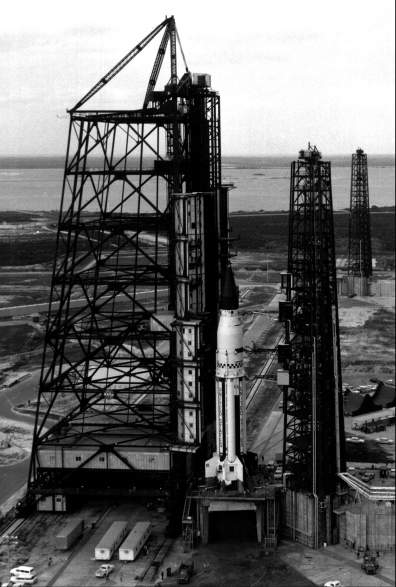
The Cracked Sleeves
Although the S-IV erection was the major activity on 11 October, that day's status report also mentioned the discovery of a cracked sleeve on the "S-1 engine position #3 hydraulic package, yaw actuator, low pressure return line."29 The sleeve, a centimeter-long metal cylinder, was an integral part of end-fitting assemblies on hundreds of pneumatic and hydraulic line joints in the first stage. Technicians replaced the sleeve on the 15th and continued the check of the hydraulic actuator. The incident, however, caused concern in Huntsville where Chrysler personnel had reported similar sleeve failures after pressurization tests. A special investigation of S-1 engines on the 22nd found 12 more cracked sleeves. These sleeves and the affected tubing were replaced during the next two weeks. The cracked sleeves apparently had little to do with the decision in late October to delay the launch another five days. Gruene blamed the delay on contamination in the S-IV engine and time lost for a hurricane alert.30

The service structure moveing back from SA-5, November 1963
The assassination of President Kennedy slowed operations for three days, but the revised schedule was still being maintained in late November. A cryogenic tanking test on the 26th started well enough. There were only minor problems as the team went through the various phases of S-1 LOX loading: the 15% slow fill, the fast fill, topping off, and replenishment. It was evening when liquid hydrogen began to flow to the S-IV stage. Albert Zeiler, arriving at LC-37 to watch the last portion of the test, heard an explosion but could not immediately contact Andrew Pickett, the Chief of the Mechanical and Propulsion Division. Inside the blockhouse, a technician at the periscope saw fire on the pad. Television monitors picked up the flames, but gave only a vague idea of the fire's extent and location. Pickett terminated the hydrogen loading. A visit to the pad revealed the cause of the explosion. Gaseous hydrogen had leaked from a ruptured bellows in the hydrogen vent line that ran from the rocket to the burn pond. The rupture was probably caused by water seeping back into the pipe from the burn pond and then freezing when the cryogenic hydrogen entered the line. The escaping hydrogen had collected beneath the metal plates covering the vent line trench. Purging the vent line with helium quickly extinguished the fire. The launch team then detanked the propellants, leaving damage assessment for the following day.31 The fire caused Robert Moser to reschedule the cryogenics test for 6 December, put operations on a seven-day week, and predict a one-week delay for the launch.
Although there were problems on the next cryogenic test, launch was still expected before Christmas. On the 10th, however, the launch team detected its fourth cracked sleeve in two days. The discovery of seven more cracked sleeves the following day caused Marshall to postpone the launch for a month despite a successful simulated flight test on the 13th. In the interim the launch team replaced all of the sleeves* in critical pneumatic and hydraulic circuits.32
The cracked sleeves were not the last of SA-5's problems. During the simulated flight test, D. C. McMath's RF and telemetry section had experienced radio interference in the 400- to 450-megacycle band. Results of an RF check on 23 December provided no holiday cheer as three of SA-5's four command destruct receivers responded to an Air Force Range signal, 42 megacycles above that used for the Saturn destruct command. Although McMath was anxious to unscramble the signal-mixing, further testing had to wait two weeks for complete external RF silence. January tests appeared to place the source of signal mixing within the service structure, but when the structure was removed on the 14th, the interference continued. Suspicion next turned to the umbilical tower, and the possibility "that RF signals transmitted from the vehicle are being mixed [there] to produce the interference." The launch was nine days away when the RF section finally ran a satisfactory test on the 18th. Even so, the source of trouble was not definitely identified. Since some team members still considered the UDOP tracking station a possible source of interference, McMath recommended removal of the UDOP power amplifier.33
* The sleeve failure was attributed to a change in specifications and the longer length of SA-5 checkout. SA-5's sleeves had been cast at a different temperature from previous sleeves and one result was the appearance of carbon pockets in the stainless steel cylinders. These carbon pockets reduced the "long-life" factor (measured in seconds of operational life for some rocket hardware). MSFC eventually scrapped 22,000 defective sleeves.
| Next |